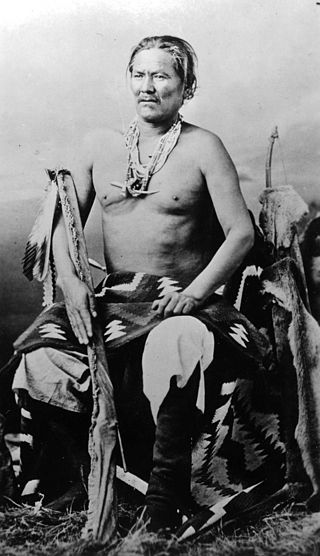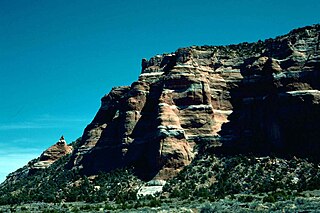Related Research Articles

Chiricahua is a band of Apache Native Americans.
The Apache are several Southern Athabaskan language–speaking peoples of the Southwest, the Southern Plains and Northern Mexico. They are linguistically related to the Navajo. They migrated from the Athabascan homelands in the north into the Southwest between 1000 and 1500 CE.
Lipan Apache are a band of Apache, a Southern Athabaskan Indigenous people, who have lived in the Southwest and Southern Plains for centuries. At the time of European and African contact, they lived in New Mexico, Colorado, Oklahoma, Texas, and northern Mexico. Historically, they were the easternmost band of Apache.
Indigenous peoples of Arizona are the Native American people who currently live or have historically lived in what is now the state of Arizona. There are 22 federally recognized tribes in Arizona, including 17 with reservations that lie entirely within its borders. Reservations make up over a quarter of the state's land area. Arizona has the third largest Native American population of any U.S. state.

Mescalero or Mescalero Apache is an Apache tribe of Southern Athabaskan–speaking Native Americans. The tribe is federally recognized as the Mescalero Apache Tribe of the Mescalero Apache Reservation, located in south-central New Mexico.

Jicarilla Apache, one of several loosely organized autonomous bands of the Eastern Apache, refers to the members of the Jicarilla Apache Nation currently living in New Mexico and speaking a Southern Athabaskan language. The term jicarilla comes from Mexican Spanish meaning "little basket", referring to the small sealed baskets they used as drinking vessels. To neighboring Apache bands, such as the Mescalero and Lipan, they were known as Kinya-Inde.

Morris Edward Opler, American anthropologist and advocate of Japanese American civil rights, was born in Buffalo, New York. He was the brother of Marvin Opler, an anthropologist and social psychiatrist.
Mescalero-Chiricahua is a Southern Athabaskan language spoken by the Chiricahua and Mescalero people in Chihuahua and Sonora, México and in Oklahoma and New Mexico. It is related to Navajo and Western Apache and has been described in great detail by the anthropological linguist Harry Hoijer (1904–1976), especially in Hoijer & Opler (1938) and Hoijer (1946). Hoijer & Opler's Chiricahua and Mescalero Apache Texts, including a grammatical sketch and traditional religious and secular stories, has been converted into an online "book" available from the University of Virginia.
Lipan is an Eastern Southern Athabaskan language spoken by the Lipan Apache in the states of Coahuila and Chihuahua in northern Mexico, some reservations of New Mexico and parts of southern Texas. Lipan belongs to the Na-Dene languages family and it is closely related to Jicarilla language, which is also part of the Eastern Southern Athabaskan languages.

The Navajo are a Native American people of the Southwestern United States.

The Fort Apache Indian Reservation is an Indian reservation in Arizona, United States, encompassing parts of Navajo, Gila, and Apache counties. It is home to the federally recognized White Mountain Apache Tribe of the Fort Apache Reservation, a Western Apache tribe. It has a land area of 1.6 million acres and a population of 12,429 people as of the 2000 census. The largest community is in Whiteriver.

The Zuni Indian Reservation, also known as Pueblo of Zuni, is the homeland of the Zuni tribe of Native Americans. In Zuni language, the Zuni Pueblo people are referred to as A:shiwi, and the Zuni homeland is referred to as Halona Idiwan’a meaning Middle Place.

Oasisamerica is a cultural region of Indigenous peoples in North America. Their precontact cultures were predominantly agrarian, in contrast with neighboring tribes to the south in Aridoamerica. The region spans parts of Northwestern Mexico and Southwestern United States and can include most of Arizona and New Mexico; southern parts of Utah and Colorado; and northern parts of Sonora and Chihuahua. During some historical periods, it might have included parts of California and Texas as well.

The Apache Scouts were part of the United States Army Indian Scouts. Most of their service was during the Apache Wars, between 1849 and 1886, though the last scout retired in 1947. The Apache scouts were the eyes and ears of the United States military and sometimes the cultural translators for the various Apache bands and the Americans. Apache scouts also served in the Navajo War, the Yavapai War, the Mexican Border War and they saw stateside duty during World War II. There has been a great deal written about Apache scouts, both as part of United States Army reports from the field and more colorful accounts written after the events by non-Apaches in newspapers and books. Men such as Al Sieber and Tom Horn were sometimes the commanding officers of small groups of Apache Scouts. As was the custom in the United States military, scouts were generally enlisted with Anglo nicknames or single names. Many Apache Scouts received citations for bravery.

Chief Naiche was the final hereditary chief of the Chiricahua band of Apache Indians.
The Fort Sill Apache Tribe of Oklahoma is the federally recognized Native American tribe of Chiricahua Warm Springs Apache in Oklahoma.

Southern Athabaskan is a subfamily of Athabaskan languages spoken primarily in the Southwestern United States with two outliers in Oklahoma and Texas. The languages are spoken in the northern Mexican states of Sonora, Chihuahua, Coahuila and to a much lesser degree in Durango and Nuevo León. Those languages are spoken by various groups of Apache and Navajo peoples. Elsewhere, Athabaskan is spoken by many indigenous groups of peoples in Alaska, Canada, Oregon and northern California.

Chato was a Chiricahua Apache subchief who carried out several raids on settlers in Arizona in the 1870s. His Apache name was Bidayajislnl or Pedes-klinje. He was a protege of Cochise, and he surrendered with Cochise in 1872 going to live on the San Carlos Reservation in southern Arizona, where he became an Apache Scout. Following his service as a scout he was taken prisoner after being coerced to travel to Washington, D.C. Chato was imprisoned in St. Augustine, Florida along with almost 500 other Apache at Fort Marion.

The Indigenous peoples of the North American Southwest are those in the current states of Colorado, Arizona, New Mexico, Utah, and Nevada in the western United States, and the states of Sonora and Chihuahua in northern Mexico. An often quoted statement from Erik Reed (1666) defined the Greater Southwest culture area as extending north to south from Durango, Mexico to Durango, Colorado and east to west from Las Vegas, Nevada to Las Vegas, New Mexico. Other names sometimes used to define the region include "American Southwest", "Northern Mexico", "Chichimeca", and "Oasisamerica/Aridoamerica". This region has long been occupied by hunter-gatherers and agricultural people.
References
- ↑ "Archived copy" (PDF). Archived from the original (PDF) on 2011-04-29. Retrieved 2014-05-07.
{{cite web}}: CS1 maint: archived copy as title (link) 2010 Census Bureau - ↑ State DOTs and Native American Nations
- ↑ Language Magazine » Census Shows Native Languages Count
- ↑ Newman, Stanley. (1996). Sketch of the Zuni language. In I. Goddard (Ed.) Handbook of North American Indians: Languages (Vol. 17, pp. 483–506). Washington: Smithsonian Institution.